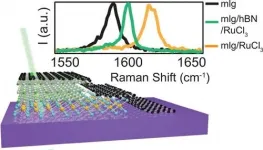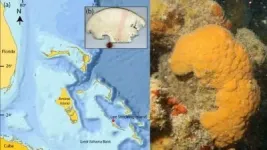(Press-News.org) A wide breadth of behaviors surrounding oral sex may affect the risk of oral HPV infection and of a virus-associated head and neck cancer that can be spread through this route, a new study led by researchers at the Johns Hopkins Kimmel Cancer Center suggests. These findings add nuance to the connection between oral sex and oropharyngeal cancer -- tumors that occur in the mouth and throat -- and could help inform research and public health efforts aimed at preventing this disease.
The findings were reported Jan. 11 in the journal Cancer.
In the early 1980s, researchers realized that nearly all cervical cancer is caused by the human papillomavirus (HPV), a DNA virus from the Papillomaviridae family. Although about 90% of HPV infections cause no symptoms and resolve within two years, a minority of people retain the virus, which can damage DNA and trigger malignancies. Nearly two decades after uncovering this link, scientists discovered that a growing number of oropharyngeal cancers are also caused by HPV. Now, the majority of oropharyngeal cancers are HPV-related.
Early research suggested that the higher a person's number of oral sex partners over a lifetime, the greater their risk of HPV-related oropharyngeal cancer. However, says Virginia Drake, M.D., first author of the study and a surgical resident at the Johns Hopkins Kimmel Cancer Center, little was known about what other risk factors might contribute to this disease.
"Although we know that HPV-related oropharyngeal cancer is strongly associated with oral sex and the number of oral sex partners," she says, "we haven't really looked at what other behaviors might contribute to this disease."
To answer this question, Drake and her colleagues worked with data from 163 patients with HPV-associated oropharyngeal cancer who were enrolled in the Papillomavirus Role in Oral Cancer Viral Etiology (PROVE) study and 345 healthy people with demographic characteristics similar to those of the study participants. The study ran from 2013 to 2018 at the Johns Hopkins Kimmel Cancer Center, the University of California San Francisco Helen Diller Family Comprehensive Cancer Center and the Tisch Cancer Institute at Icahn School of Medicine at Mount Sinai.
Each of these volunteers -- patients with cancer and healthy controls -- took the same detailed behavioral survey on lifetime and recent sexual behaviors, including number of partners, age of sexual initiation, type and order of sexual acts, partner dynamics and extramarital sex. They also submitted a blood sample to test for antibodies to strains of HPV and tumor samples from the patients with cancer to confirm presence of the virus.
When the researchers compared data from the patients who had cancer with data from the healthy controls, they found several key differences. For example, although the researchers confirmed that a higher number of lifetime oral sex partners increased the risk of HPV-related oropharyngeal cancer, they also found higher risk was linked to an earlier age of having oral sex (under 18), higher oral sex "intensity" (more sex partners over a shorter time) and having oral sex before other kinds of sex.
The research team, which included Gypsyamber D'Souza, Ph.D., professor of epidemiology and international health at the Johns Hopkins Bloomberg School of Public Health with a joint appointment in oncology and otolaryngology-head and neck surgery, also found that relationship dynamics and partner behavior can affect risk. For example, a higher number of casual sex partners, extramarital sex and suspicion that a partner had extramarital sex also significantly raised the risk of HPV-associated oropharyngeal cancer, by more than 1.6 times. Having a sexual partner who was at least 10 years older when the study participant was younger than age 23 was also associated with diagnosis of disease.
Those with cancer universally tested positive for serum antibodies to HPV oncogenes. And risk of HPV-related oropharyngeal cancer was significantly higher for volunteers who were positive for more distinct HPV strains.
Together, Drake explains, these findings add context to which behaviors might affect the risk of this disease. They also could inform future research on how HPV-related oropharyngeal cancers develop -- regarding questions such as whether people have a more robust immune response to HPV, and therefore a lower risk of cancer, if their first HPV exposure is to genital HPV (before they are exposed to oral HPV) or if they are exposed at older ages.
"Our biggest goal was to add context to what we already know about these cancers and gain a better understanding of the complex nature of this disease," Drake says. "This contemporary look into HPV-related oropharyngeal risk factors allows us to do just that."
INFORMATION:
Other Johns Hopkins researchers who contributed to this study are Carole Fakhry, Melina Windon, Matthew Stewart, Lee Akst, Alexander Hillel, Wade Chien, Christine Gourin, Rajarsi Mandal, Wojtek Mydlarz, Lisa Rooper, Tanya Troy, Siddhartha Yavvari and David Eisele.
This study was supported by the National Institute of Dental and Craniofacial Research (grant P50 DE019032) and the National Institute on Deafness and Other Communication Disorders (grant 1K23DC014758).
The higher a person's income, the more likely they were to protect themselves at the early stages of the Covid-19 pandemic in the United States, Johns Hopkins University economists find.
When it comes to adopting behaviors including social distancing and mask wearing, the team detected a striking link to their financial well-being. People who made around $230,000 a year were as much as 54% more likely to increase these types of self-protective behaviors compared to people making about $13,000.
"We need to understand these differences because we can wring our hands, and we can blame and shame, but in a way it doesn't matter," said Nick Papageorge, the Broadus Mitchell Associate Professor of Economics. "Policymakers just need to recognize who is going ...
Physicists at Washington University in St. Louis have discovered how to locally add electrical charge to an atomically thin graphene device by layering flakes of another thin material, alpha-RuCl3, on top of it.
A paper published in the journal Nano Letters describes the charge transfer process in detail. Gaining control of the flow of electrical current through atomically thin materials is important to potential future applications in photovoltaics or computing.
"In my field, where we study van der Waals heterostructures made by custom-stacking atomically ...
ATLANTA--Compared to standard machine learning models, deep learning models are largely superior at discerning patterns and discriminative features in brain imaging, despite being more complex in their architecture, according to a new study in Nature Communications led by Georgia State University.
Advanced biomedical technologies such as structural and functional magnetic resonance imaging (MRI and fMRI) or genomic sequencing have produced an enormous volume of data about the human body. By extracting patterns from this information, scientists can glean ...
Philadelphia, January 14, 2021--Based on preclinical studies of an investigational drug to treat peripheral nerve tumors, researchers at Children's Hospital of Philadelphia (CHOP) as part of the Neurofibromatosis Clinical Trials Consortium have shown that the drug, cabozantinib, reduces tumor volume and pain in patients with the genetic disorder neurofibromatosis type 1 (NF1). The results of the Phase 2 clinical trial, co-chaired by Michael J. Fisher, MD at CHOP, were published recently in Nature Medicine.
"This is the second class of drugs to demonstrate ...
Many animal and insect species use Batesian mimicry - mimicking a poisonous species - as a defense against predators. The common palmfly, Elymnias hypermnestra (a species of satyrine butterfly), which is found throughout wide areas of tropical and subtropical Asia, adds a twist to this evolutionary strategy: the females evolved two distinct forms, either orange or dark brown, imitating two separate poisonous model species, Danaus or Euploea. The males are uniformly brown. A population group is either entirely brown (both males and females) or mixed (brown males and orange females).
City College of New York entomologist David Lohman and his collaborators studied the genome of 45 samples representing 18 subspecies across Asia to determine ...
While new research from West Virginia University economists finds that presidential inaugurations have gained popularity as must-see tourist events in recent years, major security threats will keep visitors away for the inauguration of President-Elect Joe Biden.
Published in "Tourism Economics," the study, by Joshua Hall, chair and professor of economics, and economic doctoral student Clay Collins, examined the impact of the inaugurations of Barack Obama and Donald Trump on hotel occupancy in the Washington, D.C.-area.
Daily occupancy rates around the inaugurations were four-to-six times higher than the next largest event in the sample. The research team also concluded ...
To achieve full occupancy, hotels used to rely exclusively on experience, concentration and human abilities. Then came online booking, which made the reservation collection process faster, but did not solve the risk of turning down long stays because of rooms previously booked for short stays.
To avoid overbooking (accepting more reservations than there is room for) in some cases online sales are blocked before hotels are completely booked. The solution that the University of Trento has just discovered could change the life of hotels by increasing the number of occupied rooms and, therefore, in the revenue of hotel owners.
For an average Italian hotel (50 rooms), ...
More than half of all university students in the United States have experienced high levels of psychological impact from the COVID-19 pandemic, according to a new study published in the open-access journal PLOS ONE by Matthew Browning of Clemson University, US, and colleagues.
University students are increasingly recognized as a psychologically vulnerable population, suffering from higher levels of depression, anxiety, substance abuse and disordered eating compared to the general population. Moreover, college students have been among the most strongly affected by COVID-19 because of uncertainty regarding academic success, future careers and social life during college, among other concerns.
In the new study, researchers collected data on 2,534 students ...
Investors who bet on tropical forest conservation and reforestation to solve global warming by storing carbon in wood face huge uncertainties because the science behind predicting carbon stocks is still shaky. Even the best Earth Systems Models fail to predict how carbon stored by tropical forests varies from place to place. The New Phytologist invites scientists doing the "most-exciting, ground-breaking research" to review timely topics in a way that non-scientists can understand. Helene Muller-Landau, staff scientist at the Smithsonian Tropical Research Institute (STRI) was chosen to write the authoritative Tansley Review ...
MIAMI--Scientists used a 600-year-old marine sponge to reconstruct a record of ocean temperature in the North Atlantic revealing past volcanic activity as well as the current global warming trend from the release of carbon dioxide and other heat trapping gasses into Earth's atmosphere and absorbed by the oceans.
The University of Miami (UM) Rosenstiel School of Marine and Atmospheric Science-led research team used geochemical proxies to reconstruct a 600 year-long record of Atlantic Ocean temperatures from the skeleton of a sclerosponge (Ceratoporella nicholsoni).
The basketball-sized sclerosponge was ...





